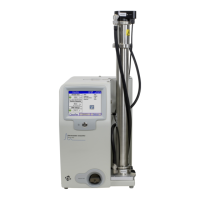Theory of Operation B-15
SMPS S p ectr o m e ter Measur e m ent Theor y
The SMPS size distribution measurement is based on a voltage scanning
process as described by Wang and Flagan (1990). The voltage is
exponentially increased with progressing sampling time between a lower
and upper voltage limit. Therefore, the transfer function of the DMA - which
is assumed to be triangular in shape and is described by its peak electrical
mobility Z and its half width ΔZ – continuously “moves” across the particle
size range to be measured. For given DMA geometry (outer radius r
1
, inner
radius r
2
and effective DMA length L
eff
) and given flow rates, Z
*
depends
only on the DMA voltage V (see Equation B-5).
The TSI SMPS 3938 Spectrometer uses sheath flow re-circulation,
therefore Equation B-6 applies to calculate ΔZ, which is proportional to the
peak mobility Z*; the ratio of aerosol flow rate to sheath flow rate during a
voltage scan is constant.
During a voltage scan with a scan time t
scan
between the start voltage V
tf
and the end voltage V
max
, the DMA voltage is always precisely controlled.
The DMA voltage curve over time must equal V
tf
=V(Z
min
) at t=t
f
(t
f
is the
time, particles need to pass through the DMA) and V
max
=V(Z
max
) at t=t
scan
.
Here, Z
min
and Z
max
are the electrical mobilities of singly charged particles
with the lower boundary diameter of the first size bin to be measured and
the upper boundary diameter of the last size bin to be measured,
respectively. Equation B-4 is applied for the calculation of Z(D).
Accordingly, Equation B-5 relates the particles’ electrical mobility to the
DMA voltage. The DMA voltage as function of time can be described by:
fscan
f
tt
tt
tf
max
tf
V
V
V)t(V
Equation B-8
In an SMPS Spectrometer, the particle detector (typically a CPC) is
connected to the monodisperse aerosol outlet port of the DMA with tubing.
The transport time through this tubing, together with the internal response
time of the detector, is the delay time t
d
. Therefore, particles C(t) counted
during a scan by the particle detector at time t have an electrical mobility
corresponding to t-t
d
.
Equation B-9
While running a scan, the Electrostatic Classifier Model 3082 records the
number of counted particles C in time intervals Δt of 20 ms (or with a
sampling frequency of 50 Hz). The time series of counted particles C
i
for all
time intervals i sampled in a scan – together with all parameters describing
the measurement – is stored as SMPS raw data.

